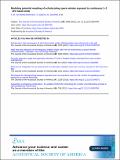Files in this item
Modeling potential masking of echolocating sperm whales exposed to continuous 1–2 kHz naval sonar
Item metadata
| dc.contributor.author | von Benda-Beckmann, A M | |
| dc.contributor.author | Isojunno, S | |
| dc.contributor.author | Zandvliet, M | |
| dc.contributor.author | Ainslie, M A | |
| dc.contributor.author | Wensveen, P J | |
| dc.contributor.author | Tyack, P L | |
| dc.contributor.author | Kvadsheim, P H | |
| dc.contributor.author | Lam, F P A | |
| dc.contributor.author | Miller, P J O | |
| dc.date.accessioned | 2022-01-17T16:30:10Z | |
| dc.date.available | 2022-01-17T16:30:10Z | |
| dc.date.issued | 2021-04-30 | |
| dc.identifier | 274077901 | |
| dc.identifier | c7aed4c0-e79e-4149-b278-c36343cdbd0d | |
| dc.identifier | 85105282914 | |
| dc.identifier | 000646687900001 | |
| dc.identifier.citation | von Benda-Beckmann , A M , Isojunno , S , Zandvliet , M , Ainslie , M A , Wensveen , P J , Tyack , P L , Kvadsheim , P H , Lam , F P A & Miller , P J O 2021 , ' Modeling potential masking of echolocating sperm whales exposed to continuous 1–2 kHz naval sonar ' , Journal of the Acoustical Society of America , vol. 149 , no. 4 , pp. 2908-2925 . https://doi.org/10.1121/10.0004769 | en |
| dc.identifier.issn | 0001-4966 | |
| dc.identifier.other | Bibtex: VonBenda-Beckmann2021 | |
| dc.identifier.other | ORCID: /0000-0002-2212-2135/work/93514405 | |
| dc.identifier.other | ORCID: /0000-0002-8409-4790/work/93514690 | |
| dc.identifier.uri | https://hdl.handle.net/10023/24683 | |
| dc.description | This study was sponsored by the U.S. Living Marine Resources program, Office of Naval Research (ONR) Grant Nos. N00014-18-1-2062 and N00014-20-1-2709, UK Defence Science and Technology Laboratory (DSTL), French Direction générale de l'armement (DGA), and the Netherlands Ministry of Defence. | en |
| dc.description.abstract | Modern active sonar systems can (almost) continuously transmit and receive sound, which can lead to more masking of important sounds for marine mammals than conventional pulsed sonar systems transmitting at a much lower duty cycle. This study investigated the potential of 1–2 kHz active sonar to mask echolocation-based foraging of sperm whales by modeling their echolocation detection process. Continuous masking for an echolocating sperm whale facing a sonar was predicted for sonar sound pressure levels of 160 dB re 1 μPa2, with intermittent masking at levels of 120 dB re 1 μPa2, but model predictions strongly depended on the animal orientation, harmonic content of the sonar, click source level, and target strength of the prey. The masking model predicted lower masking potential of buzz clicks compared to regular clicks, even though the energy source level is much lower. For buzz clicks, the lower source level is compensated for by the reduced two-way propagation loss to nearby prey during buzzes. These results help to predict what types of behavioral changes could indicate masking in the wild. Several key knowledge gaps related to masking potential of sonar in echolocating odontocetes were identified that require further investigation to assess the significance of masking. | |
| dc.format.extent | 18 | |
| dc.format.extent | 5685086 | |
| dc.language.iso | eng | |
| dc.relation.ispartof | Journal of the Acoustical Society of America | en |
| dc.subject | GC Oceanography | en |
| dc.subject | QH301 Biology | en |
| dc.subject | T-NDAS | en |
| dc.subject | SDG 14 - Life Below Water | en |
| dc.subject.lcc | GC | en |
| dc.subject.lcc | QH301 | en |
| dc.title | Modeling potential masking of echolocating sperm whales exposed to continuous 1–2 kHz naval sonar | en |
| dc.type | Journal article | en |
| dc.contributor.institution | University of St Andrews. School of Biology | en |
| dc.contributor.institution | University of St Andrews. Sea Mammal Research Unit | en |
| dc.contributor.institution | University of St Andrews. Scottish Oceans Institute | en |
| dc.contributor.institution | University of St Andrews. Institute of Behavioural and Neural Sciences | en |
| dc.contributor.institution | University of St Andrews. Centre for Social Learning & Cognitive Evolution | en |
| dc.contributor.institution | University of St Andrews. Bioacoustics group | en |
| dc.contributor.institution | University of St Andrews. Marine Alliance for Science & Technology Scotland | en |
| dc.contributor.institution | University of St Andrews. Centre for Research into Ecological & Environmental Modelling | en |
| dc.identifier.doi | https://doi.org/10.1121/10.0004769 | |
| dc.description.status | Peer reviewed | en |
This item appears in the following Collection(s)
Items in the St Andrews Research Repository are protected by copyright, with all rights reserved, unless otherwise indicated.

